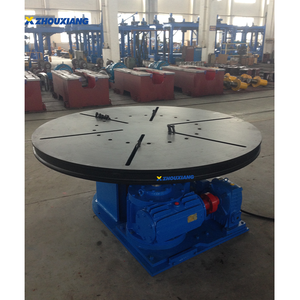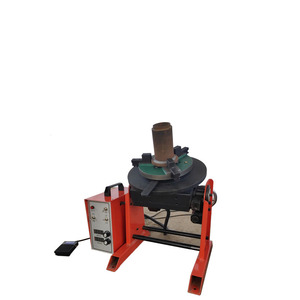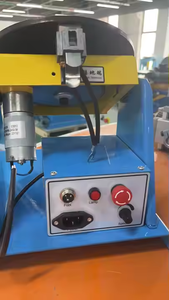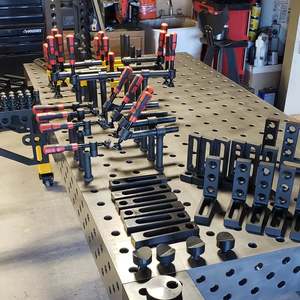
All categories
Featured selections
Trade Assurance
Buyer Central
Help Center
Get the app
Become a supplier

(4143 products available)




















































rotating welding table are essential components in the realm of welding, designed to hold and rotate workpieces steadily and efficiently during welding operations. These devices enhance productivity and precision by allowing welders to access hard-to-reach areas and ensure uniform welds. rotating welding table are particularly beneficial in applications requiring the welding of cylindrical or round objects, as they provide stable positioning and rotational capabilities. By utilizing rotating welding table, welders can achieve consistent results, reduce manual handling, and improve safety in the workplace. Their role in the welding industry is indispensable, making them a sought-after solution for various welding tasks.
There are several types of rotating welding table available, each catering to different welding requirements. The most common types include manual positioners, automatic positioners, and programmable positioners. Manual positioners are operated by hand, suitable for smaller tasks and limited budgets. Automatic positioners, on the other hand, offer motorized rotation, ideal for more complex welding applications requiring precise control. Programmable positioners allow for custom settings and automated sequences, providing enhanced flexibility and efficiency for high-volume production runs. Each type of rotating welding table is designed to meet specific needs, ensuring optimal performance in various welding environments.
rotating welding table offer a range of functions and features that enhance welding operations. These devices provide stable support and rotation capabilities, allowing for continuous welding without frequent adjustments. Features such as adjustable speed controls, multi-axis rotation, and tilt functions enable welders to achieve precise angles and positions. Additionally, rotating welding table can be equipped with remote controls for easy operation and integration with automated welding systems. The capacity to handle heavy loads and accommodate various workpiece sizes makes rotating welding table versatile tools for diverse welding applications. These features contribute to improved weld quality, reduced production time, and increased overall efficiency.
The construction of rotating welding table involves the use of robust materials and components to ensure durability and reliability. Typically, these devices are made from high-strength steel or aluminum, offering excellent load-bearing capabilities and resistance to wear and tear. Components such as gearboxes, motor drives, and control panels are integrated to provide smooth and precise movement. Bearings and shafts are carefully selected to withstand the demands of rotational and tilting motions. The choice of materials and components impacts the performance and longevity of rotating welding table, ensuring they can withstand the rigors of industrial welding environments. Manufacturers continually innovate with advanced materials to enhance the durability and functionality of rotating welding table.
To maximize the benefits of rotating welding table, it is crucial to understand their operation and maintenance. Begin by selecting the appropriate type of positioner for the specific welding task and workpiece size. Set the desired rotation speed and angle using the control panel or remote. Ensure the workpiece is securely attached to the positioner to prevent movement during welding. Regularly inspect and maintain rotating welding table by checking for wear on components and lubricating moving parts. Proper usage and maintenance of rotating welding table not only improve welding accuracy but also extend the lifespan of the equipment. Training operators on the effective use of rotating welding table can further enhance productivity and safety in welding processes.
Choosing the appropriate rotating welding table for your welding operations involves several key factors. First and foremost, consider the weight and size of the workpieces you will be handling. The capacity of the rotating welding table must be sufficient to support the heaviest and largest items without compromising stability. Additionally, assess the rotational and tilting capabilities of the equipment. For complex geometries or multi-directional welding tasks, a rotating welding table with multi-axis rotation and adjustable tilt will provide the flexibility needed for precise welding. Understanding these requirements ensures the selected rotating welding table aligns perfectly with your specific needs.
Another crucial consideration is the level of automation required. Manual rotating welding table may suffice for basic tasks and smaller projects, but for high-volume production or intricate welding operations, automatic or programmable positioners are preferable. These advanced systems offer motorized control and programmable settings that enhance efficiency and consistency. Additionally, evaluate the ease of integration with existing welding systems. A compatible rotating welding table will seamlessly integrate with robotic or automated welding setups, streamlining processes and minimizing downtime.
Regular maintenance is vital to extend the lifespan of rotating welding table and ensure optimal performance. Key practices include inspecting components for wear and tear, lubricating moving parts, and checking electrical systems for faults. Regularly cleaning the device and ensuring all fasteners are secure will also prevent operational issues. Implementing a routine maintenance schedule helps identify potential problems early, reducing the likelihood of costly repairs.
rotating welding table enhances safety by providing stable support and reducing the need for manual handling of heavy workpieces. This minimizes the risk of accidents related to lifting or repositioning items. Additionally, the ability to position workpieces at optimal angles reduces the likelihood of weld defects, ensuring safer and more reliable outcomes. Operators can focus on the welding process without worrying about the stability of the workpiece.
While rotating welding table is highly versatile, they are especially beneficial for welding cylindrical or round objects. However, they can also be adapted for various welding types and applications, including MIG, TIG, and arc welding. The adaptability of rotating welding table makes them a valuable asset in diverse welding environments, though specific models may be better suited to particular tasks. Understanding the compatibility of a positioner with your welding method is crucial for achieving the best results.
One of the primary challenges is ensuring the rotating welding table is correctly calibrated for the specific task. Incorrect settings can lead to misalignment and suboptimal weld quality. Additionally, handling very large or irregularly shaped workpieces may require specialized accessories or adjustments to the positioner. Overcoming these challenges involves meticulous planning and potentially investing in custom solutions to accommodate unique requirements.
Yes, rotating welding table can be customized to meet specific application needs. Customization options may include altering the size and capacity, integrating additional control features, or modifying the mounting system to suit unique workpieces. Working closely with manufacturers to design a positioner that caters to specific welding tasks ensures enhanced efficiency and productivity. Customization allows businesses to optimize their welding operations for maximum output and quality.